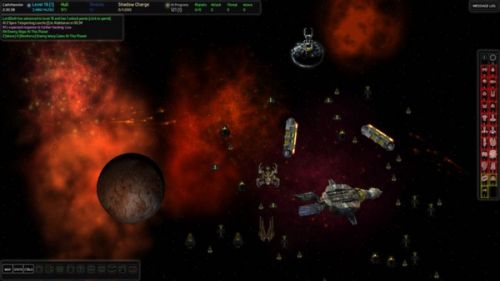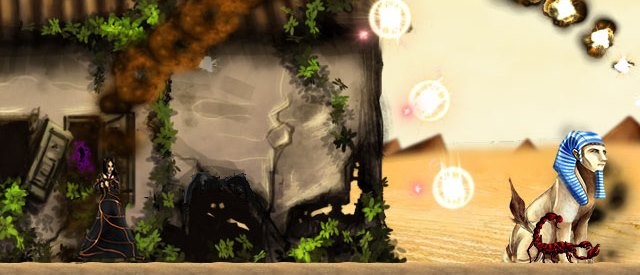Co-Optimus: It’s hard to believe that it’s only been a little over 3 years since we last did an interview with you, and in that time, your studio has released five games: A.I. War (2009), Tidalis (2010), A Valley Without Wind (2012), A Valley Without Wind 2 (2013), and Shattered Haven (2013). Don’t you guys ever get tired, or take a break? How do you keep the momentum going?
Chris Park: Wow, has it been that long? Time sure flies when you’re busy, I guess. When it comes to making games, I think the big advantage that we have on speed mainly comes from having a really streamlined process. I come from a business coding background, and we had very rigorous standards when it came to code organization and reuse and design patterns. These things all speed up coding, and I carried those over into Arcen. And as we’ve been proceeding, we’ve been gathering up more and more engine components that get carried forward into our newer games.
But further than that, as these years have progressed, we’ve also grown as a company. What started out as literally just me is now six fulltime staff, a contract art studio, and a couple of other direct contractors. I haven’t been actively soliciting for positions in general, but have just taken the opportunity to snap up individuals that stood out to me whenever I encountered them and had a potential opening. Having a dedicated team of self-motivated, talented individuals really makes a big difference.
Designing with a team to toss ideas around, rather than one person sitting alone and doing it, also helps enormously. On all fronts, things move much faster now than they did three years ago, and we’re actually able to do two projects at once rather than just one at a time, now. That helps keep things fresh -- each project helps improve the other when you have two to focus on.
Co-Optimus: Of course those five games don’t include the constant support, patches, and - in the case of A.I. War - expansions you provide after release. Arcen really has been great with incorporating player feedback into its games. Has working with fans made the development process more complex, or does feedback cause nothing but warm fuzzy feelings all over?
Chris: Yeah, we definitely keep busy. In terms of fans making the development process more complex, I would actually say the opposite: it makes it vastly, hugely simpler. When you are sitting by yourself in a vacuum, it’s easy to overlook things. We make complicated games, and there’s just no way we could make them in that scope without the support of our playerbase.
It’s the constant feedback (not all of it warm and fuzzy) that helps keep us refining our ideas until they really shine. Having each game go through that process really gives me much more confidence that the end result is good. When it’s something that is being worked on behind closed doors, I’m always a bit antsy to get it into the hands of players and start collecting diverse opinions.

Arcen Games first came onto the scene with A.I. War - a strategy game that featured a unique approach to enemy AI
Co-Optimus: There are two themes that I feel have really been consistent in Arcen Games. The first is that you’re not going to get a “insert genre here” game. They’re often an amalgam of different ideas and genres, which can lead to some very good innovations and ideas in gaming. However, do you ever feel that some of these blends might be going a bit far? Has there been a moment in development of any game where you wish you could simplify things, but you’re just too far in to make that happen?
Chris: Definitely, that’s a big theme for us. Our games tend to exist in the space between multiple genres. Sometimes that works out more successfully than others. With Valley 1, we struggled for a year and a half trying to make all those elements gel. In the end we had to cut a lot, and the end design drifted a lot from the original intent we had when we first set out. In the end that was something where I felt like the final Valley 1 design was solid, but we had taken it as far as we could because we were backed into a corner by how the design had evolved.
So what we did was basically fork the project: we started Valley 2, and went back to our earlier conceptions with all that we had learned about the genre genre space we were occupying during the year and a half prior to that. We didn’t just patch Valley 1 because that would have really erased that game -- it is unique and interesting in its own right, and nothing like Valley 2. But I felt like we were able to really execute a tighter, more interesting design with Valley 2.
Co-Optimus: Do you find the lack of a clear label for your games hurts their popularity or sales? That people get turned off when they can’t say “oh, it’s a really good shooter” and instead have to go along the lines of “well, there are platform elements, but first you play this kind of strategy board game”?
Chris: Maybe sometimes, but it’s hard to say. With Tidalis I think that hurt us some, because it’s a really deep puzzle game that was also trying to put on a cute face and still be accessible to the casual players. That wound up being a turnoff to the hardcore players, who thought it was more shallow than it remotely was; and then all that depth scared away the casual players. So that was a misstep, although the game itself is one of our best.
When it comes to our other titles, I think that it’s a lot less clear. To a large degree we have to do things that are odd and different -- almost all indies do -- because if you just wanted a great shooter, the AAA companies can do that better. They have the manpower to crank out something with production values an indie could never match. So we’re competing on innovation and design.
With a few rare exceptions, indies are all serving niche audiences of some sort: the lesson here is that, so long as you keep your budget to an appropriate scope for your audience, it’s a very viable business strategy. It’s the sort of thing that also lets us make the kinds of games we want to make, and that gives players something they’ve never quite seen before with each game.
